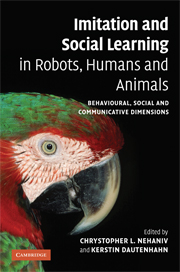 Imitation and Social Learning in Robots, Humans and Animals
Imitation and Social Learning in Robots, Humans and Animals Published online by Cambridge University Press: 10 December 2009
Intersubjectivity and turn-taking
We introduce a simulation study designed to develop a “synthetic psychology” (Braitenberg, 1984). Instead of studying real human/animal behavior, we study autonomous behavior of mobile agents that have virtual sensors to “see” the world and move around with virtual “wheels.” The autonomous behavior is synthesized by the agent's internal dynamics, which evolve using a genetic algorithm. A purpose of synthetic psychology is to create a new concept in order to understand an essential psychological phenomenon. Therefore, the simulation framework has to use models sufficiently simple to analyze the behavior, but sufficiently complex to provide a theory to understand the psychological experiments.
As an example of synthetic psychology, we describe a simulation study of turn-taking using coupled dynamical recognizers. Studying turn-taking phenomena in robot experiments (e.g. Brooks et al., 1999; Dautenhahn, 1999; Steels and Kaplan, 2001; Miyake et al., in press) stresses the importance of embodiment and situatedness. In particular, MIT AI Lab's well-designed face robot, Kismet (Kismet project, 2000), can make use of human social protocols to stimulate natural emotions and social responses in humans. Even conversational turn-taking is established with a human subject. To do this, Kismet relies on subtle cues of human expression and interaction dynamics. Dautenhahn et al. used a mobile robot and a small humanoid robot to investigate the use of robotic toys in therapy and education of children with autism (Dautenhahn et al., 2002; AuRoRA project, 2005). These robots engage in playing a game with autistic children to elicit turn-taking and imitation.
To save this book to your Kindle, first ensure [email protected] is added to your Approved Personal Document E-mail List under your Personal Document Settings on the Manage Your Content and Devices page of your Amazon account. Then enter the ‘name’ part of your Kindle email address below. Find out more about saving to your Kindle.
Note you can select to save to either the @free.kindle.com or @kindle.com variations. ‘@free.kindle.com’ emails are free but can only be saved to your device when it is connected to wi-fi. ‘@kindle.com’ emails can be delivered even when you are not connected to wi-fi, but note that service fees apply.
Find out more about the Kindle Personal Document Service.
To save content items to your account, please confirm that you agree to abide by our usage policies. If this is the first time you use this feature, you will be asked to authorise Cambridge Core to connect with your account. Find out more about saving content to Dropbox.
To save content items to your account, please confirm that you agree to abide by our usage policies. If this is the first time you use this feature, you will be asked to authorise Cambridge Core to connect with your account. Find out more about saving content to Google Drive.